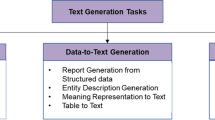Abstract
Text generation is a fundamental and important task in natural language processing. Most of the existing models generate text in a sequential manner and have difficulty modeling complex dependency structures. In this paper, we treat the text generation task as a graph generation problem exploiting both syntactic and word-ordering relationships. Leveraging the framework of the graph neural network, we propose the word graph model. During the process, the model builds a sentence incrementally and maintains syntactic integrity via a syntax-driven, top-down, breadth-first generation process. Experimental results on both synthetic and real text generation tasks show the efficacy of our approach.
Similar content being viewed by others
References
Sordoni A, Galley M, Auli M, et al. A neural network approach to context-sensitive generation of conversational responses. In: Proceedings of the 2015 Conference of the North American Chapter of the Association for Computational Linguistics: Human Language Technologies (HLT-NAACL), Denver, 2015. 196–205
Bahdanau D, Cho K H, Bengio Y. Neural machine translation by jointly learning to align and translate. In: Proceedings of the 5th International Conference on Learning Representations, 2015
Serban I V, Sordoni A, Bengio Y, et al. Building end-to-end dialogue systems using generative hierarchical neural network models. In: Proceedings of the 30th AAAI Conference on Artificial Intelligence, 2016. 3776–3784
Ranzato M A, Chopra S, Auli M, et al. Sequence level training with recurrent neural networks. In: Proceedings of the 4th International Conference on Learning Representations, 2016
Wiseman S, Rush A M. Sequence-to-sequence learning as beam-search optimization. In: Proceedings of the Conference on Empirical Methods in Natural Language Processing, Austin, 2016. 1296–1306
Bowman S R, Vilnis L, Vinyals O, et al. Generating sentences from a continuous space. In: Proceedings of the SIGNLL Conference on Computational Natural Language Learning, Berlin, 2016. 10–21
Hochreiter S, Schmidhuber J. Long short-term memory. Neural Comput, 1997, 9: 1735–1780
Chung J Y, Gulcehre C, Cho K H, et al. Empirical evaluation of gated recurrent neural networks on sequence modeling. In: Proceedings of the Advances in Neural Information Processing Systems Deep Learning Workshop, 2014
Henaff M, Burna J, LeCun Y. Deep convolutional networks on graph-structured data. 2015. ArXiv:1506.05163
Kipf T N, Welling M. Semi-supervised classification with graph convolutional networks. In: Proceedings of the 5th International Conference on Learning Representations, Toulon, 2017
Battaglia P W, Pascanu R, Lai M, et al. Interaction networks for learning about objects, relations and physics. In: Proceedings of the Thirtieth Conference on Neural Information Processing Systems, 2016. 4502–4510
Gilmer J, Schoenholz S S, Riley P F, et al. Neural message passing for quantum chemistry. In: Proceedings of the 34th International Conference on Machine Learning, Sydney, 2017. 1263–1272
Bengio Y, Louradour J, Collobert R, et al. Curriculum learning. In: Proceedings of the 26th International Conference on Machine Learning, Montreal, 2009. 41–48
Bengio S, Vinyals O, Jaitly N, et al. Scheduled sampling for sequence prediction with recurrent neural networks. In: Proceedings of the 29th Conference on Neural Information Processing Systems, Montréal, 2015. 1171–1179
Yu L T, Zhang W N, Wang J, et al. SeqGAN: sequence generative adversarial nets with policy gradient. In: Proceedings of the 31st AAAI Conference on Artificial Intelligence, 2017. 2852–2858
Guo J X, Lu S D, Cai H, et al. Long text generation via adversarial training with leaked information. In: Proceedings of the 32nd AAAI Conference on Artificial Intelligence, 2018. 5141–5148
Fedus W, Goodfellow I J, Dai A M. MaskGAN: better text generation via filling in the ____. In: Proceedings of the 6th International Conference on Learning Representations, Vancouver, 2018
Diao Q M, Qiu M H, Wu C Y, et al. Jointly modeling aspects, ratings and sentiments for movie recommendation (JMARS). In: Proceedings of the 20th ACM SIGKDD International Conference on Knowledge Discovery and Data Mining, 2014. 193–202
Papineni K, Roukos S, Ward T, et al. BLEU: a method for automatic evaluation of machine translation. In: Proceedings of the 40th Annual Meeting on Association for Computational Linguistics, 2002. 311–318
Wang K, Wan X J. SentiGAN: generating sentimental texts via mixture adversarial networks. In: Proceedings of the 27th International Joint Conference on Artificial Intelligence (IJCAI-18), 2018. 4446–4452
Vinyals O, Kaiser L, Koo T, et al. Grammar as a foreign language. In: Proceedings of the Neural Information Processing Systems, 2015. 2773–2781
Tai K S, Socher R, Manning C D. Improved semantic representations from tree-structured long short-term memory networks. In: Proceedings of the 53rd Annual Meeting of the Association for Computational Linguistics and the 7th International Joint Conference on Natural Language Processing, Beijing, 2015. 1556–1566
Dyer C, Kuncoro A, Ballesteros M, et al. Recurrent neural network grammars. In: Proceedings of the 2016 Conference of the North American Chapter of the Association for Computational Linguistics: Human Language Technologies, San Diego, 2016. 199–209
Alvarez-Melis D, Jaakkola T S. Tree-structured decoding with doubly-recurrent neural networks. In: Proceedings of the International Conference on Learning Representations, 2017
Zhou G B, Luo P, Cao R Y, et al. Tree-structured neural machine for linguistics-aware sentence generation. In: Proceedings of 32nd AAAI Conference on Artificial Intelligence, 2018. 5722–5729
Scarselli F, Gori M, Ah Chung Tsoi M, et al. The graph neural network model. IEEE Trans Neural Netw, 2009, 20: 61–80
Wu S Z, Zhang D D, Yang N, et al. Sequence-to-dependency neural machine translation. In: Proceedings of the 55th Annual Meeting of the Association for Computational Linguistics, 2017. 698–707
Li Y J, Tarlow D, Brockschmidt M, et al. Gated Graph Sequence Neural Networks. In: Proceedings of the 4th International Conference on Learning Representations, San Juan, 2016
Acknowledgements
This work was supported by National Key Research and Development Program of China (Grant No. 2018YFC0831103), Shanghai Municipal Science and Technology Major Project (Grant No. 2018SHZDZX01), and Zhejiang Lab.
Author information
Authors and Affiliations
Corresponding author
Rights and permissions
About this article
Cite this article
Guo, Q., Qiu, X., Xue, X. et al. Syntax-guided text generation via graph neural network. Sci. China Inf. Sci. 64, 152102 (2021). https://doi.org/10.1007/s11432-019-2740-1
Received:
Accepted:
Published:
DOI: https://doi.org/10.1007/s11432-019-2740-1




